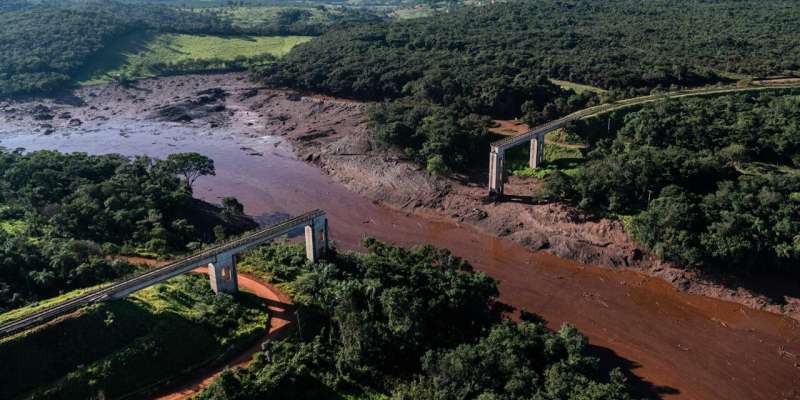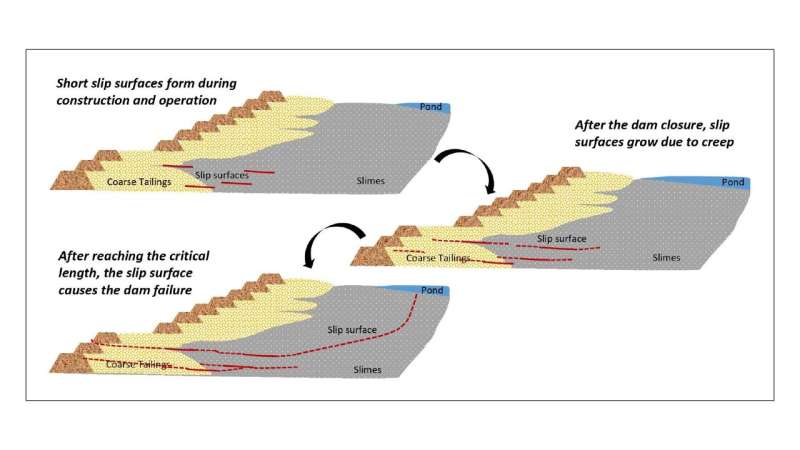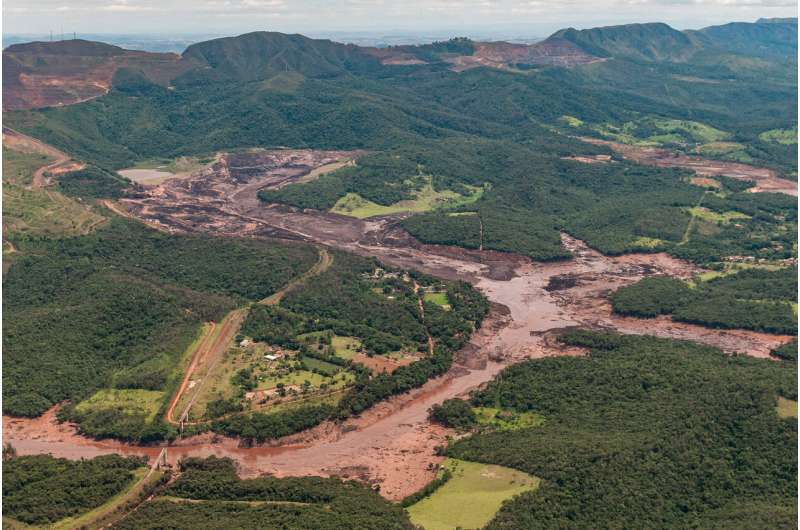This article has been reviewed according to Science X's editorial process and policies. Editors have highlighted the following attributes while ensuring the content's credibility:
fact-checked
peer-reviewed publication
trusted source
proofread
Brumadinho dam collapse: The danger emerged after the decommissioning, study reveals

The disaster near the small town of Brumadinho in southeastern Brazil occurred shortly after midday on 25 January 2019. At a nearby iron ore mine, the tailings dam—a storage area for the sludgy, fine-grained residues from ore processing, or "tailings"—collapsed.
A huge mudslide of about 10 million cubic meters of liquefied tailings flooded the site of the mine, destroying neighboring settlements and taking a railway bridge with it. At least 270 people were killed. The ecosystem of the Paraopeba River downstream of the mine was ruined. Although the dam had a monitoring system, no one had foreseen the disaster.
The Brumadinho dam collapse resulted in several lawsuits against the Vale mining company and the TÜV Süd inspection organization. Shortly before the accident, the latter had certified that the dam was sufficiently stable. Vale was ordered to pay the equivalent of about 6 billion euros in damages.
An investigation committee concluded that the accident was caused by slowly accumulating microscopic displacements (known as creep) in the deposited tailings layers, but did not provide the exact physical mechanism supporting this hypothesis. In particular, uncertainty remained as to why the dam broke in 2019 specifically—three years after the pond was last loaded with new tailings, and why no significant displacements had been detected prior to the collapse.
Physical mechanism explained
A study by Professor Alexander Puzrin, Head of the Institute of Geotechnical Engineering at ETH Zurich and an expert in landslide modeling, has now shed light on the Brumadinho disaster. The paper is published in the journal Communications Earth & Environment. The scientists used numerical and analytical models to investigate the causes of the dam failure, and they have identified a physical mechanism that explains the mining accident.
The tailings pond was built in 1976. Over the following years, the pond's earth dam was raised several times by a few meters, as is customary in ore mining, to create additional space for the storage of processing residues. The dam's steps were placed with an offset on top of each other, much like the steps of a staircase (upstream principle).
In the end, the dam consisted of 10 steps and was 86 meters tall. When the structure failed in January 2019, the initial rupture occurred at the second dam level. As a result, all 10 steps of the earth dam collapsed and, together with the liquefied accumulated tailings, ran out down into the valley as a mudslide.

Creep deformation after decommissioning
The work done by Professor Puzrin's team now shows how this could happen. According to the new findings, some initial slip surfaces had already appeared in the dammed tailings at the height of the second dam step during the dam's construction. With the progress of construction, these slip surfaces increased in length but remained too short to cause a collapse.
However, after the tailings dam was decommissioned in 2016—suggests the ETH team's modeling—these surfaces continued to expand horizontally and eventually reached a critical length. As a result, the layers of tailings began to move, causing the dam to burst under their weight and triggering the deadly mudslide.
According to the model, what caused the slip surface to grow is known as creep deformation. These deformations in the fine-grained, brittle tailings are tiny, slowly accumulating displacements caused by uneven pressure distribution between the grains in the overlying deposits.
"Other triggers such as rainfall and drilling can accelerate slip surface growth," Puzrin says, "but our model shows that creep deformation alone is sufficient for the slip surface to reach the critical extent that can trigger a dam failure."
The findings are worrying in two respects: the slip surface that caused the disaster apparently grew at a time when the pond was no longer being loaded with new tailings—in other words, without any additional external load; and the growth of the slip surface did not lead to any significant external deformation of the dam that the monitoring system could have recognized as alarming.

Model enables risk analysis
Tailings dams for processing residues from the mining of iron ore and other mineral rocks are used in large numbers worldwide. In each year since 2000, five to six cases have been recorded in which dams have failed or been damaged for various reasons. After the Brumadinho disaster and similar accidents, Brazil decommissioned tailings ponds with dams based on the upstream principle. However, the ETH study now shows that simply no longer loading a pond with new tailings may not avert the danger.
Dam breaches like the one in Brumadinho cannot yet be predicted using conventional monitoring systems. The ETH study opens up new options: "Our model can carry out a risk analysis for existing dams and predict the likelihood of a dam failure," Puzrin says.
If a high risk is identified, there are various plausible courses of action. The risk can be reduced by pumping the water out from the boreholes in the tailings ponds. Or the tailings dam can be dismantled. In urgent cases, endangered villages can be temporarily evacuated to protect the inhabitants until the danger has been averted.
Helping to make earthen dams safer
The ETH study's findings are relevant to all tailings dams for processing residues from ore mining. This is because whenever the residues consist of fine-grained, brittle material, in the worst case slip surfaces can form over which the deposited material can slide and damage the dam.
The situation is not directly comparable with reservoirs where water is retained by an earthen dam. However, the new findings can also contribute to safety here, as Puzrin points out. "Our findings provide an indication of how to further improve the safety of earth dams in the event of an earthquake, which can generate an initial slip surface. In this respect, our work helps to make dams safer in general."
More information: Fangyuan Zhu et al, The slip surface mechanism of delayed failure of the Brumadinho tailings dam in 2019, Communications Earth & Environment (2024). DOI: 10.1038/s43247-023-01086-9
Journal information: Communications Earth & Environment
Provided by ETH Zurich





















